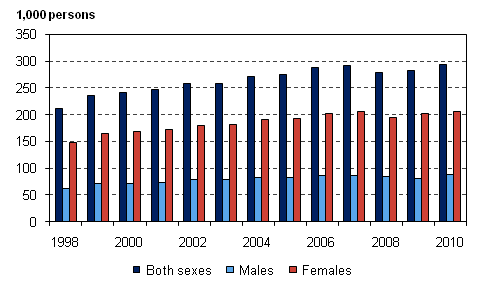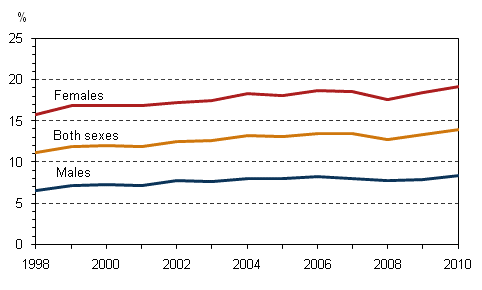2 Number of part-time employees went up slightly
2.1 Number of part-time employees highest in female-dominated industries
According to the Labour Force Survey, persons employed part-time numbered 358,000 in 2010. Of them, 294,000 were employees and 64,000 self-employed persons or assisting family members. The Labour Force Survey data on part-time employment are based on the respondents’ own reporting. The following only concerns part-time employees.
The number of part-time employees increased slightly (+11,000) from the previous year. Part-time employees accounted for 14 per cent of all employees in 2010. The long-term trend in part-time employment has been a growing one since 1998. (Figures 4 and 5.)
Part-time employment is more widespread among women than men. Among female employees, persons employed part-time numbered 207,000, or 19 per cent, and among male employees 88,000, or 8 per cent. Nearly three-quarters of the part-time employees worked in the private sector. The numbers of part-time employees were the highest in the female dominated industries of wholesale and retail trade, and health and social work. The share of part-time employees of all employees was the largest in hotel and restaurant activities at 32 per cent.
Figure 4. Part-time employees aged 15–74 by sex in 1998-2010

Figure 5. Share of part-time employees among employees aged 15–74 by sex 1998-2010, %

2.2 Studying is still the commonest reason for working part-time
Working part-time suits the life situation of many of those who are employed part-time. By contrast, part-time employment can be viewed as one form of underemployment in cases where the employee has not succeeded in finding full-time work even if he/she would have wanted it. Thus, the reasons for working part-time had not changed much between 2009 and 2010.
Working part-time is widespread among young people, for as many as 39 per cent of employees between the ages of 15 and 24 worked part-time in 2010. Studying was the commonest reason for employees to work part-time in 2010. Approximately 30 per cent of part-time employees quoted this reason. Other reported reasons related to life situation were caring for children or relatives, and health reasons. Approximately 27,000 persons, almost all of them women, reported caring for children or relatives as the reason for working part-time.
For just under one-third of part-time employees the reason for working part-time was that full-time work was not available. In 2010, the number of employees working part-time involuntarily was 82,000. Of them, 60,000 were women and 22,000 men.
Among the 55 to 64-year old employees, the number of part-time workers was 63,000, which was 17 per cent of all employees in this age group.
According to the Labour Force Survey, 40,000 persons were in part-time retirement in 2010. This is 4,000 persons more than one year previously. Under one-quarter of the persons in part-time retirement said that they worked part-time because of health reasons.
Source: Labour force survey 2010. Statistics Finland
Inquiries: Heidi Melasniemi-Uutela (09) 1734 2523, Olga Kambur (09) 1734 3565, tyovoimatutkimus@stat.fi
Director in charge: Riitta Harala
Updated 7.6.2011
Official Statistics of Finland (OSF):
Labour force survey [e-publication].
ISSN=1798-7857. 15 2010,
2 Number of part-time employees went up slightly
. Helsinki: Statistics Finland [referred: 22.12.2025].
Access method: http://stat.fi/til/tyti/2010/15/tyti_2010_15_2011-06-07_kat_002_en.html

